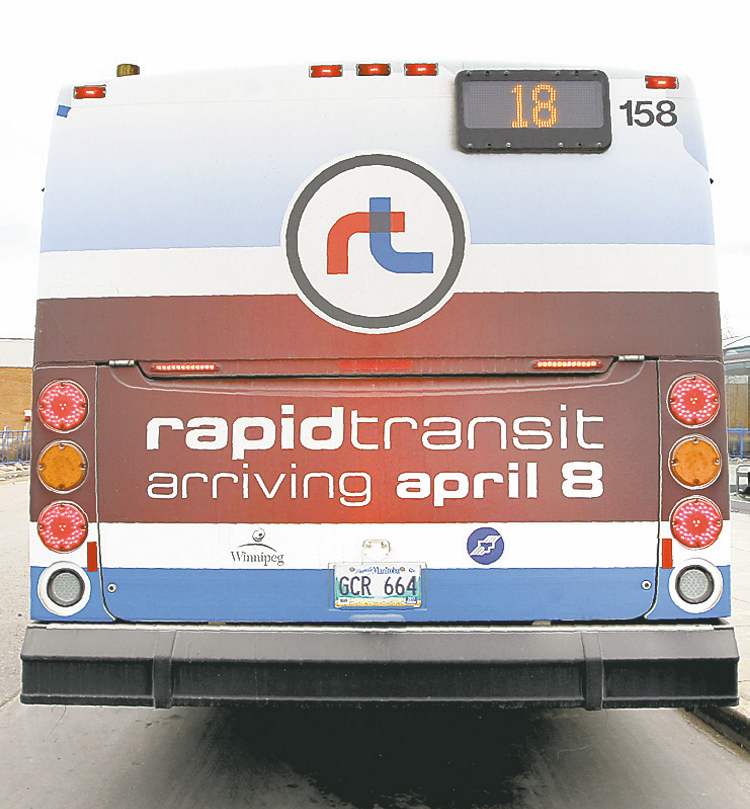Not-so-rapid transit
Advertisement
Read this article for free:
or
Already have an account? Log in here »
To continue reading, please subscribe:
Monthly Digital Subscription
$0 for the first 4 weeks*
- Enjoy unlimited reading on winnipegfreepress.com
- Read the E-Edition, our digital replica newspaper
- Access News Break, our award-winning app
- Play interactive puzzles
*No charge for 4 weeks then price increases to the regular rate of $19.00 plus GST every four weeks. Offer available to new and qualified returning subscribers only. Cancel any time.
Monthly Digital Subscription
$4.75/week*
- Enjoy unlimited reading on winnipegfreepress.com
- Read the E-Edition, our digital replica newspaper
- Access News Break, our award-winning app
- Play interactive puzzles
*Billed as $19 plus GST every four weeks. Cancel any time.
To continue reading, please subscribe:
Add Free Press access to your Brandon Sun subscription for only an additional
$1 for the first 4 weeks*
*Your next subscription payment will increase by $1.00 and you will be charged $16.99 plus GST for four weeks. After four weeks, your payment will increase to $23.99 plus GST every four weeks.
Read unlimited articles for free today:
or
Already have an account? Log in here »
Hey there, time traveller!
This article was published 07/04/2012 (4983 days ago), so information in it may no longer be current.
The long and winding road toward the beginnings of a rapid transit system in Winnipeg:
1873: The City of Winnipeg is incorporated.
1882: Transit service begins on Main Street with the operation of first horse-drawn trolleys.

1891: The first electric streetcar begins running on River Avenue.
1918: Gasoline-powered bus service begins.
1934: At the peak of Winnipeg’s streetcar system, the city boasts 193 kilometres of track.
1938: The first electric trolley bus runs down Sargent Avenue.
1955: Winnipeg’s final streetcar line is dismantled and replaced by diesel buses.
1959: A study called Future Development of Greater Winnipeg Transit System recommends the construction of three U-shaped subway lines: a Portage-North Main-Mountain route; a Pembina-William line; and an Osborne-Chalmers route. Politicians immediately deem the plan too expensive.
1966: The Winnipeg Area Transportation Study calls for the construction of a single, 8.7-kilometre subway running along Portage Avenue, Main Street and Redwood Avenue. This, too, is deemed too expensive.
1972: Mayor Stephen Juba proposes a monorail for Winnipeg.
1976: The Winnipeg Southwest Transit Corridor Study concludes a corridor for diesel buses makes more financial and operational sense than three other options: a monorail; a light-rail track; or an electric-trolley bus corridor.
1981: The first Plan Winnipeg calls for three dedicated busways: A southwest corridor along Pembina Highway, an eastern corridor along Regent Avenue and a southeast corridor to the Trans-Canada Highway.
1993: Plan Winnipeg: Toward 2010 makes relatively little mention of rapid transit. Nonetheless, the city begins buying land for the southwest corridor.
1998: Transplan 2010 recommends the city hold off on rapid transit. Glen Murray is elected mayor and creates a working group on public transportation.
2000: The working group’s final report, Direction To Our Future, recommends the construction of a rapid-transit corridor. Murray proposes a $50-million plan to finally build an abbreviated version of the southwest corridor.
2001: Plan Winnipeg 2020, calls for five busways — corridors in the southwest, northwest, eastern, northeast and a southeast.
2003: Council sets aside $1.7 million to plan and design the Southwest Transit Corridor.
2004: In March, all three levels of government announce plans to build a $51-million, 3.4-kilometre southwest corridor by 2007. Murray resigns mid-term. Newly elected Mayor Sam Katz convinces council to scrap the project and creates a Rapid Transit Task Force to review options.
2005: Katz convinces Ottawa and the province to allow Winnipeg to redirect $43 million of bus-corridor money to recreation projects. The Rapid Transit Task Force concludes the city should build two busways, to the University of Manitoba and Transcona.
2008: After Ottawa pledges $17.5 million to transit in Manitoba, the city and province re-announce plans to build a 9.6-kilometre southwest rapid transit corridor at a cost of the $327 million over six years. But funding is only confirmed for the 3.6-kilometre first phase, a $138-million link between Queen Elizabeth Way and Jubilee Avenue at Pembina Highway.
2010: Katz announces he wants to see four light-rail lines in Winnipeg and convinces council to remove the second phase of the southwest corridor from a list of city infrastructure priorities.
2011: The Transportation Master Plan identifies six rapid-transit corridors to be complete by 2031. Council approves a plan to bump up the completion date for the Southwest Transit Corridor to 2016 — and a 20-cent bus-fare hike to help pay for the work.
2012: Council rescinds the bus-fare hike, leaving funding for the second phase of the southwest corridor unresolved. The first phase is slated to open Sunday, April 8.
2031: Target for completing the east, north and west transitways, according to the Transportation Master Plan. It calls for southeast and northeast corridors to be completed after 2031.
Sources: Transportation Master Plan, Plan Winnipeg (2011), Winnipeg Rapid Transit Task Force, Master of City Planning practicum by Christopher Baker (2010), Winnipeg Transit and Free Press files.



